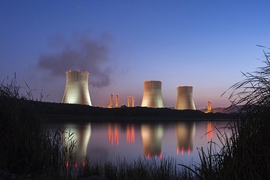In formulating policies to address greenhouse gas emissions, or evaluating the potential impact of different energy technologies on global climate change, one of the thorniest issues is how to account for the very distinctive characteristics of various different gases.
For example, methane is a potent greenhouse gas, as well as a significant byproduct of using natural gas — advocated by many as a “bridge” to a lower-emissions future. But a direct comparison between methane and carbon dioxide, the most abundant greenhouse gas emitted by human activities, is complicated: While the standard figure used for emissions trading and technology evaluation says that, gram for gram, methane is about 30 times as potent a greenhouse gas as CO2, scientists say that’s an oversimplification.
As reported in a paper published today in the journal Nature Climate Change, authored by MIT assistant professor of engineering systems Jessika Trancik and doctoral student Morgan Edwards, this conversion factor (called the global warming potential, or GWP) may significantly misvalue methane. Getting this conversion factor right is challenging because methane’s initial impact is much greater than that of CO2 — by about 100 times. But methane only stays in the atmosphere for a matter of decades, while CO2 sticks around for centuries. The result: After six or seven decades, the impact of the two gases is about equal, and from then on methane’s relative role continues to decline.
Static measures, such as the GWP, give a false sense of the gases’ impacts, and could lead to unintended climate outcomes when used as the basis for policies and planning, Trancik says. Instead, she and Edwards argue for the use of what they call “dynamic metrics,” which lead to a conversion factor that changes over time in a predictable way.
“With CO2, one cares about the cumulative emissions,” Trancik says. “But with methane, the timing of emissions matters.” The issue for regulators and planners, she says, is: “How can we take emissions timing into account, in a metric equation that is simple and predictive enough to be used?”
The authors develop a kind of metric that incorporates limited information about the future — an intended “stabilization level” for the Earth’s climate — but doesn’t require knowledge about the exact climate scenario to be followed. The researchers develop two such metrics, the instantaneous climate impact (ICI) and the cumulative climate impact (CCI); the latter is more conservative in earlier years.
The paper shows that the choice of how to quantify the effect of methane versus CO2 can have a bigger effect on the ultimate climate outcomes than uncertainties in how much leakage of methane occurs in the natural gas production system, which has recently drawn much more attention from researchers and policymakers. For this reason it is important to choose an accurate metric, and understand its properties.
“Any equivalency metric is going to be imperfect,” Trancik says, “which is why it is important to test metrics and understand their properties.” But using a measure that accounts for significant changes to the climate over time should allow for more realistic assessments of the effects of policy decisions — such as in setting environmental regulations, or deciding where to focus research investment.
While it is generally assumed that the climate impact of natural gas to produce electricity is approximately half that of coal, she says, that comparison depends on timing: The figure is true today, but within three decades, compared with coal-fired power plants, the advantage of natural gas is roughly halved under common stabilization goals. Similarly, compressed natural gas as a transportation fuel actually ends up being worse than gasoline within a couple of decades, the authors report.
In the case of natural gas, it’s not the emissions from the plants burning the gas that produce methane; rather, it is the leakage of methane — the main component of natural gas — during drilling and transportation of the fuel. So there is potential to reduce the impact of natural gas by investing in better control of such leakage, Trancik says.
More accurate comparisons of the effects of methane and CO2 can also be important when evaluating other technologies that produce emissions of more than one type of gas. For example, the study found that algae-based biofuels that incorporate a biodigester may leak enough methane to outweigh the emissions benefits over corn ethanol — a consideration that may weigh on decisions about which technology designs should be invested in and how they should be regulated, she says.
Daniel Johansson, an assistant professor of energy and environment at Chalmers University in Sweden who was not involved in this research, calls this work “a valuable contribution to the scientific literature,” and says the authors “show that the ranking of different technologies in terms of their relative climate impact depends on the proximity to a global climate stabilization target. … This goes beyond the current state of art when doing technology assessment.”
The research was partly funded by the U.S. Department of Transportation, through the New England University Transportation Center at MIT.








